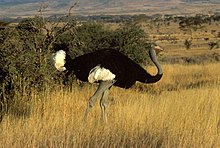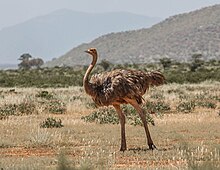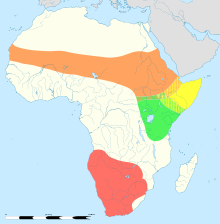| Somali ostrich | |
|---|---|

| |
| Male at Lewa Wildlife Conservancy, Kenya | |

| |
| Female at Samburu National Reserve, Kenya | |
| Conservation status | |
 Vulnerable (IUCN 3.1) | |
| CITES Appendix I (CITES) | |
| Scientific classification | |
| Domain: | Eukaryota |
| Kingdom: | Animalia |
| Phylum: | Chordata |
| Class: | Aves |
| Infraclass: | Palaeognathae |
| Order: | Struthioniformes |
| Family: | Struthionidae |
| Genus: | Struthio |
| Species: | S. molybdophanes |
| Binomial name | |
| Struthio molybdophanes Reichenow, 1883 | |

| |
| Yellow area shows range of Struthio molybdophanes | |
| Synonyms | |
| |
The Somali ostrich (Struthio molybdophanes), also known as the blue-necked ostrich, is a large flightless bird native to the Horn of Africa. It is one of two living species of ostriches, the other being the common ostrich. It was also previously considered a subspecies of the common ostrich, but was identified as a distinct species in 2014.
Taxonomy and systematics
Struthio molybdophanes was first described in the Norddeutsche allgemeine Zeitung Sunday Supplement of 16 September 1883 by Anton Reichenow, who noted the ostrich's distribution as extending over the plains of Somali- and western Galla-Land on the east coast of Africa from 10 degrees north to the Equator. Molecular evidence indicates that the East African Rift has served as a geographic barrier to isolate the taxon from the nominate subspecies, the North African ostrich S. c. camelus, while ecological and behavioural differences have kept it genetically distinct from the neighbouring Masai ostrich S. c. massaicus. An examination of the mitochondrial DNA of Struthio taxa, including the extinct Arabian ostrich S. c. syriacus, has found that the Somali ostrich is phylogenetically the most distinct, appearing to have diverged from their common ancestor some 3.6 to 4.1 million years ago.
Description
Though generally similar to other ostriches, the skin of the neck and thighs of the Somali ostrich is blue (rather than pinkish), becoming bright blue on the male during the mating season. The neck lacks a typical broad white ring, and the tail feathers are white. The males are larger than the females. The Somali ostrich is similar in size to other ostriches so far as is known, perhaps averaging marginally smaller in body mass than some subspecies of common ostrich (at least the nominate race, S. c. camelus). Reportedly Somali ostriches in captivity weigh about 105 kg (231 lb) but this may not be an accurate weight for wild birds as captive animals have feeding accesses not available to wild ostriches. It is thus one of the two largest extant bird species.
Distribution and habitat
The Somali ostrich is mostly found in the Horn of Africa, especially in north-eastern Ethiopia, southern Djibouti, most of Kenya, and across most of Somalia.
Behaviour and ecology
The Somali ostrich is differentiated ecologically from the common ostrich, with which there is some range overlap, by preferring bushier, more thickly vegetated areas, where it feeds largely by browsing, whereas the common ostrich is mainly a grazer on open savanna. There are also reports of interbreeding difficulties between the two taxa.
Status and conservation
A report to the IUCN in 2006 suggests that the Somali ostrich was common in the central and southern regions of Somalia in the 1970s and 1980s. However, following the political disintegration of that country and the lack of any effective wildlife conservation, its range and numbers there have since been shrinking as a result of uncontrolled hunting for meat, medicinal products and eggs, with the bird facing eradication in the Horn of Africa. In Kenya it is farmed for meat, feathers and eggs.
Notes
- Only populations of Algeria, Burkina Faso, Cameroon, Central African Republic, Chad, Mali, Mauritania, Morocco, Niger, Nigeria, Senegal and Sudan. No other populations are included in the CITES Appendices.
References
- ^ BirdLife International (2016). "Struthio molybdophanes". IUCN Red List of Threatened Species. 2016: e.T22732795A95049558. doi:10.2305/IUCN.UK.2016-3.RLTS.T22732795A95049558.en. Retrieved 20 November 2021.
- "Appendices | CITES". cites.org. Retrieved 2022-01-14.
- "Somali Ostrich". Avibase.
- Redman, N.; Stevenson, T.; Fanshawe, J. (2016). Birds of the Horn of Africa: Ethiopia, Eritrea, Djibouti, Somalia, and Socotra - Revised and Expanded Edition. Princeton Field Guides. Princeton University Press. p. 34. ISBN 978-0-691-17289-7. Retrieved 2018-11-21.
- Dr. Reichenow (16 September 1883). "Immer Neues aus Afrika". Sonntags-Beilage zur Norddeutschen allgemeinen Zeitung (in German). No. 37. p. 148 .
- Reichenow, Anton (October 1883). "Immer Neues aus Afrika". Mittheilungen des Ornithologischen Vereines in Wien (in German). 7 (10): 202.
- ^ Freitag, Stephanie & Robinson, Terence J. (1993). "Phylogeographic patterns in mitochondrial DNA of the Ostrich (Struthio camelus)" (PDF). The Auk. 110 (3): 614–622. doi:10.2307/4088425. JSTOR 4088425.
- Robinson, Terence J. & Matthee, Conrad A. (1999). "Molecular genetic relationships of the extinct ostrich, Struthio camelus syriacus: consequences for ostrich introductions into Saudi Arabia". Animal Conservation. 2 (3): 165–171. Bibcode:1999AnCon...2..165R. doi:10.1111/j.1469-1795.1999.tb00062.x.
- ^ Shanawany, M.M. & Dingle, John (1999). Ostrich production systems, Part 1. Food and Agriculture Organisation. p. 12. ISBN 978-92-5-104300-4.
- Roots, Clive (2006). Flightless birds. Greenwood Press. p. 26. ISBN 0-313-33545-1.
- Davids, A. H. (2011). Estimation of genetic distances and heterosis in three ostrich (Struthio camelus) breeds for the improvement of productivity (Doctoral dissertation, Stellenbosch: University of Stellenbosch).
- Amir, Osman G. (2006). Wildlife trade in Somalia (PDF). World Conservation Union – Species Survival Commission. p. 12. Archived from the original on July 18, 2011.